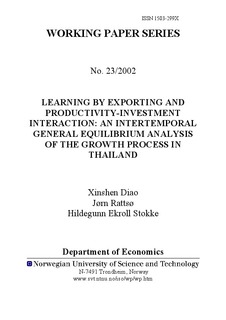| dc.contributor.author | Diao, Xinshen | nb_NO |
| dc.contributor.author | Rattsø, Jørn | nb_NO |
| dc.contributor.author | Stokke, Hildegunn E. | nb_NO |
| dc.date.accessioned | 2014-12-19T14:31:57Z | |
| dc.date.available | 2014-12-19T14:31:57Z | |
| dc.date.created | 2006-10-05 | nb_NO |
| dc.date.issued | 2002 | nb_NO |
| dc.identifier | 126117 | nb_NO |
| dc.identifier.uri | http://hdl.handle.net/11250/267163 | |
| dc.description.abstract | While the discussion of Thailand and East Asian growth has been a controversy between capital accumulation and productivity stories, we analyze the general equilibrium interaction between productivity and investment in an intertemporal model. The model builds in endogenous productivity spillover effects influencing profitability and investment and produces long run growth effects of economic policy. To understand the growth process in Thailand, learning by exporting is assumed to be the main vehicle of international spillover and brings further productivity effects to the domestic economy. The dynamic simulations show how high economic growth is prolonged by multisector productivity and investment dynamics and structural shift from agriculture to exportables. The importance of trade liberalization is shown in a counterfactual analysis where protection holds back growth by serving as a barrier to productivity spillover. | nb_NO |
| dc.language | eng | nb_NO |
| dc.publisher | Institutt for samfunnsøkonomi | nb_NO |
| dc.relation.ispartofseries | Working Paper Series, 1503-299X; 2002:24 | nb_NO |
| dc.title | Learning by Exporting and Productivity-Investment Interaction: An Intertemporal General Equilibrium Analysis of the Growth Process in Thailand | nb_NO |
| dc.type | Research report | nb_NO |
| dc.contributor.department | Norges teknisk-naturvitenskapelige universitet, Fakultet for samfunnsvitenskap og teknologiledelse, Institutt for samfunnsøkonomi | nb_NO |
